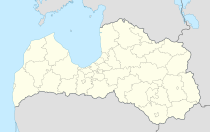Aglona
| Aglona ( German : Aglohn) | ||
|---|---|---|
 Help on coat of arms |
|
|
| Basic data | ||
| State : |
|
|
| Landscape: | Latgale ( Latvian : Latgale ) | |
| Administrative district : | Aglonas novads | |
| Coordinates : | 56 ° 8 ' N , 27 ° 1' E | |
| Residents : | 1,771 (Jul 1, 2018) | |
| Area : | 131.7 km² | |
| Population density : | 13 inhabitants per km² | |
| Height : | 145 m | |
| Website: | www.visitaglona.lv | |
| Post Code: | ||
| ISO code: | ||
Aglona (German Aglohn ) is the capital of the municipality of the same name ( Aglonas novads ) in the Latvian part of Latgale . In 2018 the community had 1771 inhabitants. Aglona is about 40 km NNE of the city of Daugavpils and is famous for the baroque pilgrimage church.
location
The place of pilgrimage is located on a narrow strip of land between the lakes Cirišs and Egles and arose from a merger of the settlements of Aglona, Somerseta and Jaunciems . The nearby Sacrificial Island (Latvian: Upursala), Teufelssee (Latvian: Velnezers), Madelan Castle (Latvian: Madelāņu pilskalns) and the surrounding pine forests make Aglona a popular destination. Traditionally, many families from Russia also spend their summer holidays here.
basilica
In 1699 the Dominican Order founded a monastery in Aglona. The miraculous image of Our Lady of Aglona , which the Dominicans presumably brought here from Lithuania , is significantly older. As it attracted more and more pilgrims , today's Basilica of the Assumption of Mary was built between 1768 and 1780 , and the icon of Mary was added to the high altar. The hill is the spiritual center of the Catholics in the otherwise Lutheran Latvia, and the pilgrimage basilica is the most important Catholic church in the country. The interior of the baroque basilica is decorated with grisaille paintings in the Rococo style. It is visited annually by over 50,000 believers, especially on the feast of the Assumption on August 15th. Many votive offerings testify to answers to prayer. The basilica is located at a spring that is said to have healing powers.
In 1980 the church celebrated the 200th day of consecration and was given the rank of minor basilica by Pope John Paul II . In 1986 the 800th anniversary of the Christianization of Latvia was celebrated here. Pope John Paul II visited the pilgrimage site in September 1993, accompanied by 300,000 pilgrims from Latvia and neighboring countries. It is one of the 8 international Catholic shrines in the world .
Aglonas novads
In 2009, the administrative district of Aglona ( Aglonas novads ) was formed from Aglona and the neighboring communities of Grāveri, Kastuļina and Šķeltova . In 2018 it had 3542 inhabitants.
history
After the German occupation in World War II , the murdered on August 22, 1941 Rollkommando Hamann 269 men, 227 women and 48 children as "insane" in Aglohn.
literature
- Astrīda Iltnere (ed.): Latvijas Pagasti, Enciklopēdija. Preses Nams, Riga 2002, ISBN 9984-00-436-8 .
- Leonhards Latkovskis: Aglona. A history of the church and monastery . Publishing House of the Latgalian Culture Center, Rēzekne 2009, ISBN 978-9984-29-169-7 .
Web links
- Aglona in detail ( Memento from September 6, 2007 in the Internet Archive ) at Latgale Research Center ( Memento from May 28, 2010 in the Internet Archive )
- Aglona Basilica (Engl.)
- visitAglona tourist site about Aglona and Latgalia (engl.)
- Aglona - Heart of Latvian Catholicism - A contribution by the church historian Prof. Dr. Rudolf Grulich
Individual evidence
- ↑ a b Latvijas iedzīvotāju skaits pašvaldībās (= population figures of the self-governing districts of Latvia), as of July 1, 2018 (Latvian), p. 1, accessed on January 8, 2019.
- ↑ Leonard Latkovskis: Aglona. A history of the church and monastery . Publishing House of the Latgalian Culture Center, Rēzekne 2009, pp. 21-22.
- ↑ Leonard Latkovskis: Aglona. A history of the church and monastery . Publishing House of the Latgalian Culture Center, Rēzekne 2009, p. 31.
- ↑ Leonard Latkovskis: Aglona. A history of the church and monastery . Publishing House of the Latgalian Culture Center, Rēzekne 2009, pp. 39-40.
- ↑ gcatholic.org
- ↑ Page 5 ( Memento from August 18, 2011 in the Internet Archive )


